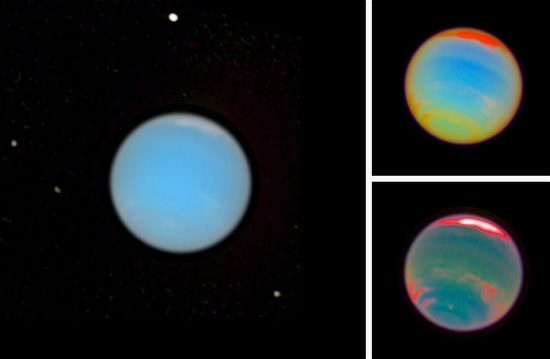
The planet Neptune in visible light (left) showing Proteus (top), Larissa (lower right), Despina and Galatea (left). Top right, enhanced color, bottom right methane patterns in its atmosphere. Credit: NASA, ESA, E. Karkoschka (University of Arizona), and H.B. Hammel (Space Science Institute, Boulder, Colorado)
April 18, 2017
Mysterious Neptune.
Sir,—The Planet [Neptune] whose position you marked out actually exists. On the day on which your letter reached me, I found a star of the eighth magnitude, which was not recorded in the excellent map designed by Dr. Bremiker, containing the twenty-first hour of the collection published by the Royal Academy of Berlin. The observation of the succeeding day showed it to be the Planet of which we were in quest.
— Letter from Johan Galle to Urbain Le Verrier. Galle found a star at the position predicted in a letter he received from Le Verrier that same day.
Jupiter’s average wind speed is about 400 kilometers per hour, with the fastest winds streaming around the Great Red Spot at 635 kilometers per hour. Saturn’s winds are clocked by Cassini at 1800 kilometers per hour, while the Hubble Space Telescope observed clouds on Uranus blowing at 900 kilometers per hour. On Neptune, a place so cold that nitrogen, oxygen, and argon could freeze into solids, winds are moving at almost 2000 kilometers per hour.
Conventional theories state that wind is caused by convection: cold air flows into areas of warm air, thought to be caused by solar energy heating different atmospheric regions. A major issue for planetary scientists is why distant gas giants, receiving the least solar energy, exhibit the greatest convection. The Sun is 900 times dimmer at Neptune than seen on Earth, yet average winds on Earth are a mere 56 kilometers per hour, with the fastest velocity recorded on December 17, 1997: 378 kilometers per hour on the island of Guam.
It is not logical that Neptune’s wind speed should be from a distant Sun heating the gas giant planet. Neptune is 49,500 kilometers in diameter and the Sun is an average of 4.486 X 10^6 kilometers away. That such a tiny pinpoint of light in space—little more than a bright star from Neptune’s perspective—could stimulate this large effect does not fit with consensus viewpoints.
Astronomers, as well as Electric Universe advocates, are at a disadvantage when it comes to Neptune. Voyager 2 is the only space probe to visit the frozen giant, flying by on its rendezvous with deep space at almost 62,000 kilometers per hour, 4900 kilometers above Neptune’s north pole. Since seasons on Neptune are around 40 years long (based on a 165 year orbit and 29 degree inclination), not much data about changes in its atmosphere is available.
On July 12, 2011 Neptune completed its first orbit around the Sun since its discovery on September 23, 1846. Detailed observations of the giant planet by the Hubble Space Telescope are limited, since it is at such a great distance. For example, spectrographic data about Neptune is available for the last 30 years or so, meaning that only about 25% of any seasonal variations on Neptune have been observed.
Neptune’s condition, based on a fluid dynamic model derived from atmospheric convection, ignores the electrical environment in which all members of the Solar System are immersed. For example, wind is defined as the movement of air molecules. Electric Universe theory agrees with that idea, but there is more to the explanation. Electric discharges in planetary atmospheres are common throughout the Solar System, possibly on Neptune as well. Since lightning requires the separation of electric charge, cloud layers of varying density and composition could be a clue to that phenomenon. Neptune exhibits high-altitude methane clouds, a hydrogen sulfide-methane layer, and layers of water and ammonium hydrosulfide deeper down. So-called “whistlers” are detected in Neptune’s magnetosphere, but no direct observation of lightning.
If wind is supposed to be nothing more than convection and gas kinetics, Electric Universe proponents would insist that electric discharges also generate wind. Electromagnetic forces move and accelerate charged particles in plasma, so neutral air molecules get dragged along. Laboratory arc discharges reveal that an electric “wind” surrounds and often precedes an electric arc.
It is principally electrical energy and not heat that powers Neptune’s winds. Having the strongest winds in the Solar System, while being farthest from the Sun, contradicts any thermal models and convection currents. Plasma discharges in Neptune’s atmosphere are probably sweeping up the surrounding air along with the charge carriers, or ions. No doubt the same phenomenon on a greater or lesser scale is happening in the atmospheres of every planet. The accepted explanation of thunderstorms on Earth caused by convection created from the Sun’s heat, alone, is open to question.
Stephen Smith












